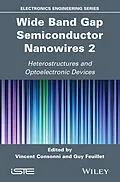This book, the second of two volumes, describes heterostructures and optoelectronic devices made from GaN and ZnO nanowires.
Over the last decade, the number of publications on GaN and ZnO nanowires has grown exponentially, in particular for their potential optical applications in LEDs, lasers, UV detectors or solar cells. So far, such applications are still in their infancy, which we analyze as being mostly due to a lack of understanding and control of the growth of nanowires and related heterostructures. Furthermore, dealing with two different but related semiconductors such as ZnO and GaN, but also with different chemical and physical synthesis methods, will bring valuable comparisons in order to gain a general approach for the growth of wide band gap nanowires applied to optical devices.
Autorentext
Vincent Consonni is Associate Scientist at CNRS (French National Center for Research) in France. His research has focused on the physics of crystal growth and of condensed matter for micro- and nano-structures involving compound semiconductors such as CdTe, GaN, ZnO and SnO2. He is currently working on transparent conductive materials and ZnO nanowire-based solar cells. He has published approximately 30 articles in peer-reviewed journals.
Guy Feuillet is Senior Scientist at CEA (French Atomic and Alternative Energy Commission), France. He has initiated and coordinated many internal programs (GaN nanostructures, X-ray detectors for medical imaging, solid state lighting) and R&D programs during his work at CEA. He is a permanent member of the scientific advisory board at CEA/LETI, and a member of the selection committee for the French National Agency for Research (ANR). He has published about 120 papers in peer-reviewed journals.
Inhalt
PREFACE xi
PART 1. GaN AND ZnO NANOWIRE HETEROSTRUCTURES 1
CHAPTER 1. AlGaN/GaN NANOWIRE HETEROSTRUCTURES 3
Jörg TEUBERT, Jordi ARBIOL and Martin EICKHOFF
1.1. A model system for AlGaN/GaN heterostructures 3
1.2. Axial AlGaN/GaN nanowire heterostructures 4
1.2.1. Structural properties of axial AlGaN/GaN nanowire heterostructures 5
1.2.2. Optical properties of axial AlGaN/GaN nanowire heterostructures 8
1.2.3. Lateral internal electric fields 12
1.2.4. Axial internal electric fields 14
1.2.5. Optical characterization of single-AlGaN/GaN nanowires containing GaN nanodisks 15
1.2.6. Electrical transport properties 18
1.3. AlGaN/GaN coreshell nanowire heterostructures 19
1.3.1. Structural properties 20
1.3.2. Optical characteristics 23
1.3.3. Electronic properties 24
1.3.4. True one-dimensional GaN quantum wire second-order self-assembly 28
1.4. Application examples 29
1.4.1. AlGaN/GaN nanowire heterostructure optochemical gas sensors 30
1.4.2. AlGaN/GaN nanowire heterostructure resonant tunneling diodes 33
1.5. Conclusions 34
1.6. Bibliography 35
CHAPTER 2. InGaN NANOWIRE HETEROSTRUCTURES 41
Bruno DAUDIN
2.1. Introduction 41
2.2. Self-assembled InGaN nanowires 43
2.3. X-ray characterization of InGaN nanowires 46
2.4. InGaN nanodisks and nanoislands in GaN nanowires 49
2.5. Selective area growth (SAG) of InGaN nanowires 52
2.6. Conclusion 55
2.7. Bibliography 56
CHAPTER 3. ZnO-BASED NANOWIRE HETEROSTRUCTURES 61
Guy FEUILLET and Pierre FERRET
3.1. Introduction 61
3.2. Designing ZnO-based nanowire heterostructures 63
3.3. Growth of ZnxMg1-xO/ZnO coreshell heterostructures by metal-organic vapor phase epitaxy 66
3.4. Misfit relaxation processes in Znx Mg1-xO/ZnO coreshell structures 70
3.5. Optical efficiency of coreshell oxidebased nanowire heterostructures 73
3.6. Axial nanowire heterostructures 76
3.7. Conclusions and perspectives 80
3.8. Bibliography 81
CHAPTER 4. ZnO AND Ga NANOWIRE-BASED TYPE II HETEROSTRUCTURES 85
Yong ZHANG
4.1. Semiconductor heterostructures 85
4.2. Type II heterostructures 87
4.3. Optimal device architecture 88
4.4. Electronic structure of type II coreshell nanowires 91
4.5. Synthesis of the type II coreshell nanowires and their signatures 94
4.6. Demonstration of type II effects in ZnOZnSe coreshell nanowires and photovoltaic devices 96
4.7. Summary 101
4.8. Acknowledgments 102
4.9. Bibliography 102
PART 2. INTEGRATION OF GaN AND ZnO NANOWIRES IN OPTOELECTRONIC DEVICES 105
CHAPTER 5. AXIAL GaN NANOWIRE-BASED LEDS 107
Qi WANG, Hieu N'GUYEN, Songrui ZHAO and Zetian MI
5.1. Introduction 107
5.2. Top-down GaN-based axial nanowire LEDs 108
5.2.1. Fabrication of top-down GaN-based axial nanowires 108
5.2.2. Device fabrication of axial nanowire LEDs 110
5.2.3. Performance characteristics of top-down axial nanowire LEDs 111
5.3. Bottom-up GaN-based axial nanowire LEDs 112
5.3.1. Growth techniques 112
5.3.2. Doping, polarity and surface charge properties 113
5.3.3. Design and typical performance of bottom-upaxial nanowire LEDs 114
5.4. Carrier loss processes of axial nanowire LEDs 121
5.4.1. Auger recombination 121
5.4.2. Electron overflow 122
5.4.3. Surface recombination 123
5.5. Controlling carrier loss of GaN-based nanowire LEDs 124
5.5.1. p-type modulation doping and AlGaN electron blocking layer 124
5.5.2. InGaN/GaN/AlGaN coreshell dot-in-a-wire phosphor-free white LEDs 126
5.6. Conclusions 127
5.7. Bibliography 127
CHAPTER 6. RADIAL GaN NANOWIRE-BASED LEDS 135
Shunfeng LI
